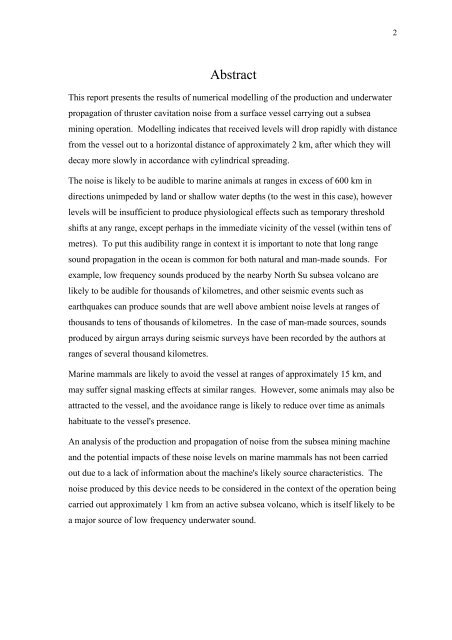Appendices 5-13 - Nautilus Cares - Nautilus Minerals
Appendices 5-13 - Nautilus Cares - Nautilus Minerals
Appendices 5-13 - Nautilus Cares - Nautilus Minerals
Create successful ePaper yourself
Turn your PDF publications into a flip-book with our unique Google optimized e-Paper software.
Abstract<br />
This report presents the results of numerical modelling of the production and underwater<br />
propagation of thruster cavitation noise from a surface vessel carrying out a subsea<br />
mining operation. Modelling indicates that received levels will drop rapidly with distance<br />
from the vessel out to a horizontal distance of approximately 2 km, after which they will<br />
decay more slowly in accordance with cylindrical spreading.<br />
The noise is likely to be audible to marine animals at ranges in excess of 600 km in<br />
directions unimpeded by land or shallow water depths (to the west in this case), however<br />
levels will be insufficient to produce physiological effects such as temporary threshold<br />
shifts at any range, except perhaps in the immediate vicinity of the vessel (within tens of<br />
metres). To put this audibility range in context it is important to note that long range<br />
sound propagation in the ocean is common for both natural and man-made sounds. For<br />
example, low frequency sounds produced by the nearby North Su subsea volcano are<br />
likely to be audible for thousands of kilometres, and other seismic events such as<br />
earthquakes can produce sounds that are well above ambient noise levels at ranges of<br />
thousands to tens of thousands of kilometres. In the case of man-made sources, sounds<br />
produced by airgun arrays during seismic surveys have been recorded by the authors at<br />
ranges of several thousand kilometres.<br />
Marine mammals are likely to avoid the vessel at ranges of approximately 15 km, and<br />
may suffer signal masking effects at similar ranges. However, some animals may also be<br />
attracted to the vessel, and the avoidance range is likely to reduce over time as animals<br />
habituate to the vessel's presence.<br />
An analysis of the production and propagation of noise from the subsea mining machine<br />
and the potential impacts of these noise levels on marine mammals has not been carried<br />
out due to a lack of information about the machine's likely source characteristics. The<br />
noise produced by this device needs to be considered in the context of the operation being<br />
carried out approximately 1 km from an active subsea volcano, which is itself likely to be<br />
a major source of low frequency underwater sound.<br />
2


